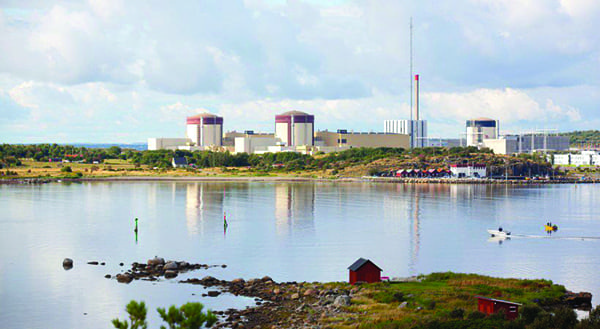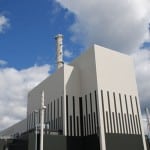Scorching temperatures during the summer of 2018 forced a swathe of power plants across the world to reduce power or shut down temporarily, owing to warmer-than-usual temperatures of cooling water and other general heat-related issues.
European countries from Scandinavia to Russia grappled with summer temperatures that were between 6C and 10C above the seasonal average. A blistering heatwave also affected a wide span of Asia and scorched parts of North America.
In France, where temperatures hit 40C (104F) in the Rhone Valley area, French utility EDF shut down the 1,335-MW Saint-Alban-1 unit, Bugey-2 and Bugey-3 (each 910 MW), and 920-MW Fessenheim-2 reactor, citing high temperatures in the Rhone and Rhine rivers. The closures sent power prices soaring in the country that relies on nuclear for 72.3% of its electricity production.
In Sweden, Vattenfall shut down the 900-MW Unit 2 at the four-unit Ringhals plant (Figure 2), as seawater temperatures exceeded 25C (77F), approaching maximum technical specifications on allowed cooling water temperature. “That the sea reaches so high temperature levels this year is very unusual, and that Swedish nuclear power plants need to reduce their output due to too warm sea water is something that only happens rarely. At Ringhals it has only happened at a few instances since the turn of the century,” the company said in a statement. Soaring temperatures also forced Vattenfall to reduce power at three boiling water reactors (BWRs) at its Forsmark plant.
On August 20, the Swedish Radiation Safety Authority asked plant operators in the country to submit plans on how they could shield reactors from high air and seawater temperatures. “The main impact of the heatwave was not on nuclear safety at the plants, but rather on their availability,” noted Michael Knochenhauer, director of the Swedish Radiation Safety Authority. The authority also plans to compile all aspects of how the nation’s reactors were affected by abnormal weather conditions, including more rain, higher air humidity, more violent thunderstorms, and forest fires in the vicinity of the plants.
In Finland, Fortum decreased power at the two-reactor, 1-GW Loviisa power plant, as seawater approached 24C, noting that the last time it was forced to reduce power in the face of warmer-than-usual cooling water was seven years ago. In Switzerland, BKW trimmed output by 41 MW at its 376-MW Mühleberg nuclear plant, owing to higher temperatures in the Aare River. In Germany, as E.ON reduced production from its Grohnde and Brokdorf nuclear power plants, warm waters forced utility Energie Baden-Württemberg AG to shut down a hard coal plant in Karlsruhe. German utility RWE also reported that low water levels in the Rhine had obstructed fuel deliveries to a hard coal plant in Westphalia. Two RWE gas plants in Dormagen and Lingen also reduced generation.
In South Korea, where the government plans to phase out nuclear power and only 16 of the country’s 24 reactors were in operation at the end of July, scorching heat prompted Korea Hydro and Nuclear Power Co. to switch on suspended nuclear plants to supply an additional 5 GW during the summer. The state-run nuclear operator rebooted Hanbit 3 and Hanul 2, which were offline for maintenance. In Japan—where only a handful of reactors have resumed operation since the Fukushima disaster in 2011—utilities fired up old oil- and gas-fired power plants to deal with soaring demand, as temperatures rose to 41.1C (106F) in some places, shattering records and prompting a mass of heatstroke-related deaths.
In China, total power generation jumped 15.3% in June compared to the year before, with 15% increases for thermal generation and a 21% surge for hydro. According to the International Energy Agency (IEA), surging temperatures also pushed up peak electricity loads, causing hand-wringing and load-shedding in Tehran, Iran, and Karachi, Pakistan—where Ramadhan, the Islamic holy fast where no food or water should be consumed until sundown, had just begun. In Pakistan, drought conditions brought water levels at its largest hydropower dams to “dead” levels.
In Texas, the regional grid operator warned of possible power shortages stemming from high power demand and a mass of recent retirements. California, which in September moved to produce 100% of its power from renewable sources by 2050, was besieged by wildfires that increased 25% this year compared to the five-year average, according to state and U.S. Forest Service data, forcing transmission lines and generation plants out of service. The state has retired 6.4 GW of thermal generation in the past four years, and restrictions on usage of the Aliso Canyon natural gas storage facility, which experienced a leak in December 2015, remain. This summer, however, the state also saw its hydropower generation plunge 30% compared to last year, leading to a greater reliance on solar, wind, and imports.
Heatwaves aren’t uncommon, as researchers noted in an October 2017 paper, “Impact of Cold Waves and Heat Waves on the Energy Production Sector,” published in the journal Atmosphere. But extreme events, which are regularly attributed to climate change, have been on the rise, and the power generating sector is especially vulnerable.
“When the air temperature becomes very high, fuel efficiency is affected due to a lower oxygen concentration in the air and thus shows a 0.1% reduction in gas and fuel powered plants for each increase of 1 [degree] C in the temperature. In the case of nuclear-powered plants, an increase of 1 [degree] C reduces the energy supply by about 0.5% via its effect on thermal efficiency. For its part every 5 [degree] C increase in water temperature represents a 1% loss of efficiency,” the authors wrote. “During droughts and heat waves, the loss of electricity production may therefore exceed 2% per degree Celsius given that refrigeration systems of power plants are limited by physical laws, regulations and access to cold water.” The authors cited a source that claims nearly 40% of nuclear power plants in Europe have already experienced refrigerating problems owing to high temperatures.
Factors such as temperature limits for discharging water could represent a loss of between 12% and 16% of the generating capacity of central and eastern U.S. power plants by the middle of the century. By 2030, water stress could prompt thermoelectric plants in Mediterranean regions to face up to 100% loss of generation capacity owing to high water temperatures, and similar strains could impact 27% of plants in the U.S. Generators also face a slew of increased operating costs, given the need for 50% to 100% more staff—and more generating capacity. The paper’s authors recommended boosting measures to manage peak demand, diversifying supply sources, as well as conducting vulnerability assessments and developing resilience plans for the energy sector both at a government and company level.
Research and development will also be significant, along with improvements in seasonal forecasts and their application in the energy sector. Pre-emptive investments to build or renovate cooling towers, or pumps with higher capacities should also be considered. From an operational standpoint, power generators could incorporate meteorological information from observations and models into daily decision algorithms. Caroline Lee, an IEA energy and climate change policy analyst, in August noted, “Resilience is enhanced when countries share experiences and best practices, which the IEA has convened through its Climate-Energy Security Nexus workshops.”
—Sonal Patel is a POWER associate editor.











